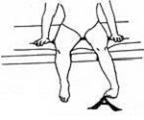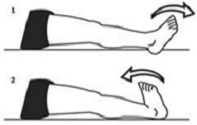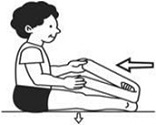Ankle sprains are one of the most common injuries in children. Ankles are made up of three bones with ligaments (tough, stretchy tissue that hold the bones together). The ligaments help stop the ankle joint from moving around too much.
Ankle sprains usually happen when there is a sudden movement or twist – often when the foot rolls over – and the ligaments are overstretched. This causes tears and bleeding (which show as bruising and swelling) around the ankle joint. These movements are more likely
to happen when a person is running, jumping or quickly changing direction e.g. in sports such as basketball, netball or football.
Signs and symptoms of ankle sprains
If your child has sprained their ankle, they may have:
- swelling, which develops in minutes or over several hours – this is caused by soft tissue damage
- pain around the outside part of the ankle joint
- bruising, which shows up within two to three days.
Care at home
If your child has sprained their ankle, you can care for them at home using first aid principles (the Rest, Ice, Compression, Elevation (RICE) strategy) and ankle exercises. Treatment should start immediately and continue for the next two to three days.
- Rest: rest the injured area and avoid activities that cause a lot of pain. If your child is having difficulty walking, crutches should be used. You can hire crutches from your local pharmacy.
- Ice: apply ice to the injured area for 10–15 minutes. Never place the ice directly on the skin because it can burn the skin – wrap the ice or ice pack in a tea towel or a pillow case. Ice the injury every two to four hours for two to three days, when your child is awake.
You can make an ice pack using a plastic bag with some ice and water in it. This moulds better to the ankle joint area than ice alone.
- Compression: use a firm bandage that is not too tight and does not stop circulation or cause extra pain. The bandage should cover from just above the ankle right down to the foot. Do not cover the toes.
- Elevation: raise the ankle whenever possible to help reduce the swelling. For example, raise your child's injured leg and rest it on some pillows while they are watching TV, reading or resting.
Some children will need medicine to help with the pain. In most cases, paracetamol is enough. Anti-inflammatory medications may help, but these are not suitable for every child. Ask your GP or local pharmacist for further advice. Always read and follow the instructions on the
package for the appropriate dose of medication for your child. See our fact sheet
Pain relief for children.
In the first two to three days after your child’s injury, avoid:
- heat (e.g. heat packs or hot baths) – this increases blood flow and makes the swelling worse
- re-injury – protect the ankle joint from re-injury by keeping weight off it and moving carefully
- massage – this promotes blood flow and makes the swelling worse.
Ankle exercises
Encourage your child to gently exercise and stretch the ankle joint. This should begin almost immediately after their injury to minimise stiffness. Start with exercise 1 and progress to exercise 4. Your child may have some mild pain at first. If
your child experiences significant pain, further rest is required. Walking on the ankle should be encouraged after two to three days if the pain is bearable. Active movement will quicken the healing process.

1. Ankle alphabet
Using the ankle and foot only, trace the letters of the alphabet from A–Z in the air.

2. Foot circles
Draw a circle in the air with the affected foot. Repeat this 10 times.

3. Foot pushes
Push the affected foot up and down 10 times.

4a. Calf stretch
With the knee straight, use a towel to gently pull the foot towards the face until a stretch is felt in the calf.
Hold this stretch for 30 seconds. Do this three times.

OR 4b. Assisted calf stretch
Help your child do the stretch. Holding the knee to keep it straight, gently pull the foot towards the face until a stretch is felt in their calf.
Hold for 30 seconds. Do this three times.
You can expect your child to fully recover from most ankle sprains in one to two weeks. The recovery time depends on your child's age, general health and the severity of the injury.
To prevent future ankle sprains, encourage your child to warm up before they exercise, and ensure they wear supportive shoes that are suitable for the sport.
When to see a doctor
Seek medical advice from your GP or a physiotherapist if:
- the pain from your child’s ankle has not improved after a few days
- your child is unable to put weight on the injured ankle immediately after the injury
- there is tenderness (pain when pressing) over the ankle bones
- you are unable to control your child’s ankle pain.
GPs and physiotherapists can examine your child's ankle, order an X-ray if needed and provide a management plan for your child's injury. If your child has ongoing or recurrent problems with their ankle, consider ankle braces or tape – your GP or physiotherapist can advise
you how to use these.
Key points to remember
- Ankle sprains are a common injury in children.
- The pain and swelling from an ankle sprain should improve within two to three days if the treatment guidelines are followed.
- Treatment includes the Rest, Ice, Compression, Elevation (RICE) strategy and ankle exercises.
- Seek medical advice if your child is unable to put weight on the injured ankle, you are unable to control their pain or it is not getting better.
For more information
Common questions our doctors are asked
When can my child start walking without
crutches again?
Encourage your child to walk on the ankle two to three days after the injury if the pain is bearable. If the pain is too bad, wait another day and try again. Your child's physiotherapist or GP can help you with this process.
If my child has had a bad ankle sprain, is it
more likely that she’ll sprain it again?
Having a sprained ankle doesn’t cause any long-term damage and won’t stretch the ligament permanently. However, some children are more likely to get sprained ankles more than once because they have loose joints.
Developed by The Royal Children's Hospital Emergency department. We acknowledge the input of RCH consumers and carers.
Reviewed March 2018.
This information is awaiting routine review. Please always seek the most recent advice from a registered and practising clinician.
Kids Health Info is supported by The Royal Children’s Hospital Foundation. To donate, visit
www.rchfoundation.org.au.